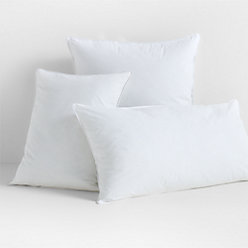Why Is Having the Right Pillow Important?
Contrary to popular belief, bed pillows are not one-size-fits-all. What you need to achieve a full night of sleep is likely different from what your partner or child needs. “A good pillow lets you comfortably lie back, while maintaining proper posture,” Matthew explains. What does this mean? That as you relax, your body is in alignment from the knees and hips, through the spine to your chest, shoulders, head and neck. If any of these body parts are positioned in a way that causes craning or twisting, it can disrupt sleep—leaving you tired the next day.
When is the Right Time to Replace a Pillow?
Our bedding experts agree that pillows should be replaced every 2 years. There are, however, a number of factors that affect this recommendation. For instance, if you’ve recently experienced changes in lifestyle or sleeping position, your pillow might need to be replaced in as little as 6 to 12 months. Is it still providing the necessary support after an extended period of time? Use the bed pillow until it’s no longer comfortable to sleep on.
What are Common Types of Pillow Filling?
The bed pillow's filling determines its firmness and the type of support it provides. From soft and fluffy to medium or firm, here are some of the most common types of filling, as detailed by our professionals:
Premium Down
Softest and most luxurious filling. It’s lightweight and breathable.
Hypoallergenic
Vegan option that has the same texture as down.
Feather-Down
Combination of feather and down filling. Firmer than premium down.
Organic
The same as premium down, with the addition of organic cotton casing.
Premium down: considered the most luxurious filling, it’s made exclusively from down (the fluffy part of the bird’s feathers), and is known for being incredibly soft. Pillows with premium down filling maintain their loft for long periods of time, are lightweight, breathable, and provide essential support for your head and neck.
Feather-down: a mixture of feather and down filling, pillows with this combination tend to be less expensive and have a slightly firmer loft.
Hypoallergenic or down-alternative: this filling emulates the texture of down. It’s made from microfiber clusters—making this fill a strong choice for people with allergies or those looking for a vegan option.
Organic: this filling has all the same features of premium down, with the addition of an organic cotton casing.

Does Sleeping Position Affect Pillow Choice?
To answer simply, yes. According to Matthew, the position in which you sleep each night is one of the most important determining factors when purchasing a pillow. He goes on to explain that there are 4 main types of sleepers: side, back, stomach and the all-around sleeper—each of which requires a different form of support.
Side
Medium to medium-firm pillows recommended.
Stomach
Soft pillows with down or hypoallergenic filling recommended
Back
Soft or firm pillows with feather-down filling recommended
All-Around
Medium to firm pillows recommended.
Side sleepers: these individuals make up the majority of the population. It’s recommended that people who sleep in this position consider using a medium to firm pillow—creating more distance between the ear and shoulder. This results in less strain while asleep.
Stomach sleepers: this sleeping position benefits the most from pillows that are flat and have either a soft down or down-alternative fill. This type of sleeper should also consider using a king pillow to help alleviate stress on the lower back.
Back sleepers: those who sleep on their back tend to get the most support from thinner pillows that keep the neck properly aligned. If you’re a snorer, consider use a firmer pillow, such as one with feather-down. For non-snorers, a softer pillow filled will ensure comfort.
All-around sleepers: also known as combination sleepers, these individuals are a tricky bunch. Ideally, they’ll have a pillow that meets the needs of all the sleeping positions mentioned above. If you’re constantly moving around while resting, consider a medium to firm bed pillow with a feather-down or down-alternative fill for proper comfort and support.
Does the Size of the Pillow Matter?
“The size of your pillow should complement the size of your bed.” Matthew says. “If you have a full or queen bed, opt for a standard-size pillow. If you have a king bed instead, go with a king-size pillow.” Euro pillows—as well as throw pillows—are purely decorative and add to the aesthetic of your bedroom.
What type of pillow helps you get your best beauty sleep? Let us know with the hashtag #CrateStyle.











